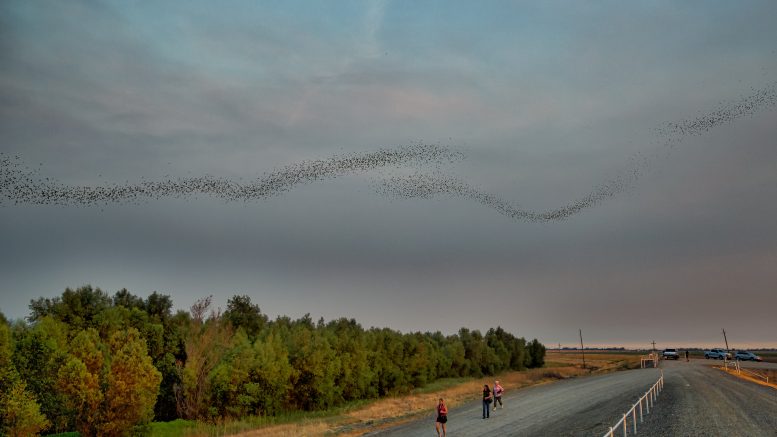By Lisa Thibodeau
On any given summer evening, as construction crews work and traffic hurtles over the Yolo Causeway, which connects West Sacramento and Davis, something mysterious is percolating below.
A large colony of Mexican free-tailed bats, who have spent the day sleeping under the warm concrete of the 3-mile-long bypass, begin to stir. As the bats awaken and their chatter becomes louder, they begin their sunset flyout in long, elegant ribbons from beneath the causeway in search of their dinner.
This Yolo County colony is the largest in California, with as many as 250,000 bats that roost and birth their pups yearly in the 16,000-acre Yolo Bypass Wildlife Area with its restored wetlands and rich habitats. Bats, which are the only mammals that fly, use their long, narrow wings to quickly (up to 99 mph) lift up over the rice fields and nearby farms in Yolo and Sacramento counties to consume the equivalent of about 500 grocery sacks full of insects nightly.
This large consumption of bugs, many of which can be destructive to crops, helps the farmers in the bats’ radius to naturally protect their fields, according to Corky Quirk, program coordinator at Yolo Basin Foundation. “You’ve got to have insect control if you are farming on a large scale. If you don’t have natural control, like the bat colony, then you are going to have to do something concerning,”
Quirk also said that relying on these beneficial insects can help some farmers reduce their use of synthetic chemicals to control pests, which the U.S. Environmental Protection Agency has warned are linked to a variety of human health issues. “With insecticides, I worry about its association with cancer and how it’s affecting our bodies and our children.”
One rice field across from the causeway is able to skip using insecticides altogether. The medium grain rice field is farmed by Mike DeWit, whose family has been growing rice in Yolo and Sutter counties since the late ’70s.
“I have never once had to spray this field using insecticide for armyworms, which pose a big problem, because they chew the leaves of the plant delaying photosynthesis, so the plant can die,” DeWit said, referencing his Sutter County field where the outcome is different. “This year I had to treat that field — there’s no bats over that field — but I have never had to treat in the bypass [field], and I’m convinced it’s because of the bats.”
There are other benefits to the wide variety of insects gobbled up by the bats, which includes moths, mosquitoes, flies, beetles, crickets and mayflies according to Ann Holmes, a doctorate research scientist who conducted a study on bat guano (droppings) at UC Davis in 2019. By extracting DNA from the guano samples to study their diet UCD researchers learned that bats also eat dangerous insects. “Bats eat agricultural pests and also mosquitos which are potential vectors for human and animal diseases,” Holmes noted.

A surprising discovery emerged from the bat guano research that Holmes led. “The Mexican free-tail bat is known for flying long distances (up to 50 miles), so they have a large range and the ability to do surveillance for agricultural pests that the state of California keeps a watch list of,” she said. “Not only are bats valuable in terms of eating bugs, but they also act as an early warning system for pests, like types of fruit flies, that are imported from other countries.”
The news, however, is not good for bat populations, a problem Quirk has devoted herself to. An estimated 52% of bat species are at risk of severely declining in the next few decades due to climate change, habitat loss and a fungus affecting bats called White-Nose Syndrome that has no known cure. Quirk also points out that using pesticides and insecticides reduces the food supply to local bat colonies.
“Roosting locations is an issue, but places to eat — that’s huge — so, when we grow native plants and don’t use pesticides in our yards we are supporting native insect populations for the bats to eat,” she said.
Other bat helpers include providing shelter and advocating for more wild and agricultural spaces. “Some farmers use hedgerows (dense trees or shrubs), which can be helpful to a wide variety of wildlife, or you can place a bat house on your property,” Quirk said, adding that the need for a dark sky is also a big concern as many species are being driven from potential foraging areas due to bright, artificial city lights. “Those lights substantially affect wildlife, decrease the insect population, and are not particularly healthy for us.”
Quirk wants to change the perception around bats as being diseased or dangerous, and instead show that they contribute to a diverse ecosystem, which in turn keeps us healthy. In addition to controlling pests, bats also pollinate plants and disperse seeds, which greatly benefits agriculture.
“I want people to know that bats are gentle animals that don’t want to attack us and that we have ways of keeping ourselves safe from wildlife,” she said. “I think the benefits greatly outweigh the risks.”
This story is part of the Solving Sacramento journalism collaborative. Solving Sacramento is supported by funding from the James Irvine Foundation and the James B. McClatchy Foundation. Our partners include California Groundbreakers, Capital Public Radio, Outword, Russian America Media, Sacramento Business Journal, Sacramento News & Review, Sacramento Observer and Univision 19.






Be the first to comment on "How Yolo County bats help sustainable farming methods "